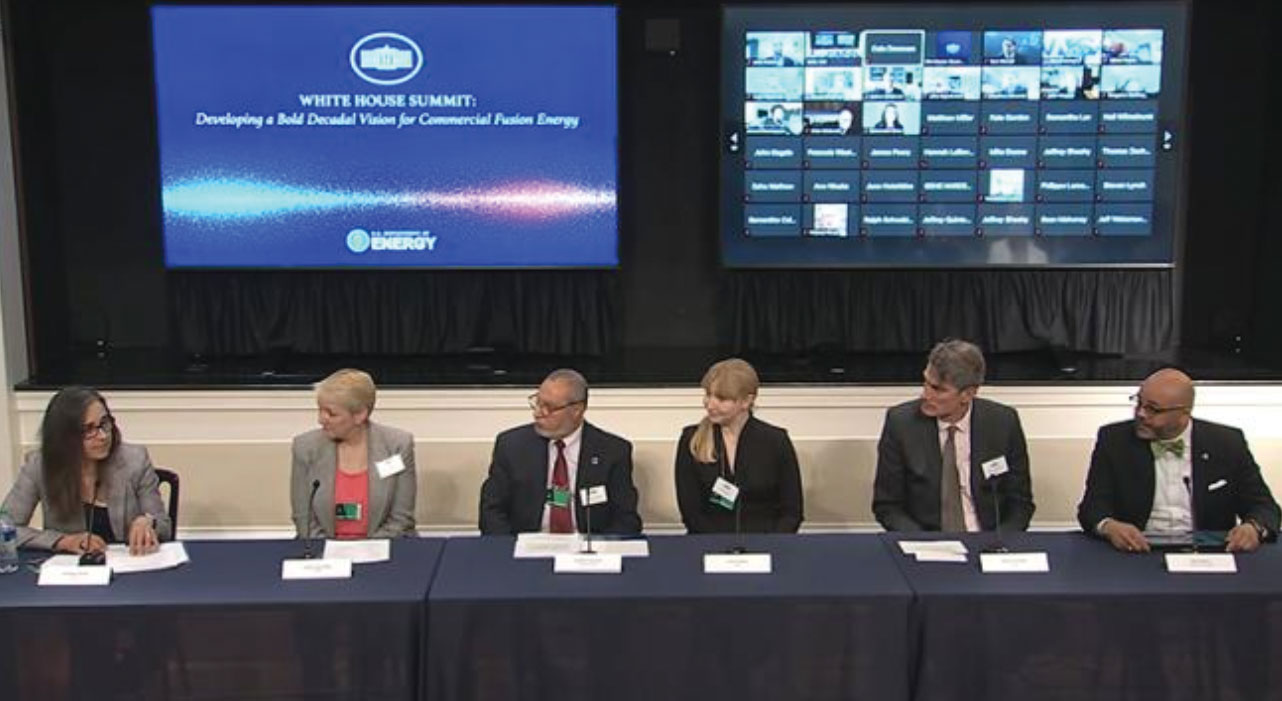Supporting stockpile stewardship through a wide range of experiments including study of fusion ignition; and operating as a national user facility for high-energy-density science
An historic inertial confinement fusion (ICF) experiment conducted on December 5, 2022, at the NIF achieved ignition and energy gain, delivering 2.05 MJ of energy and producing 3.15 MJ of fusion energy. Fired on September 19, 2022, the final experiment leading to this success produced about 1.2 MJ of fusion energy yield. Both of these experiments applied more laser energy to drive a thicker target as compared to the groundbreaking 1.35-MJ shot in August 2021. The thicker shell design improves hydrodynamic stability and provides more margin to ignite the hot spot. After the September experiment, adjustments to the laser pulse led to a more spherical implosion and successful ignition in December.
Tiny imperfections in the targets’ high-density carbon (diamond) capsules had previously stymied efforts to achieve ignition. Four earlier repeat experiments in FY 2022 failed to replicate the 1.35-MJ result achieved in August 2021. However, these shots together with months of analysis provided valuable information to help identify obstacles to success. LLNL researchers and ICF partners held a series of workshops to better understand how inherent variations in laser and target conditions affect performance. What was a bit surprising is the level of perfection that is required from the target. One key to the success of last year’s 1.35-MJ experiment was the uniquely high quality of the capsule used in the shot. The LLNL target fabrication team has taken a deeper look into the factors affecting capsule quality and is working with Diamond Materials of Freiberg, Germany, on modifying processes to improve capsule quality. In the near term, the team has revised capsule production processes in a way that should result in fewer defects.
Higher Laser Energy for ICF Experiments
For the September 2022 ICF experiment, laser operators began boosting NIF’s laser energy to a higher level of operations for ICF experiments. It was the first NIF shot to deliver more than 2 MJ of ultraviolet energy to an ICF target. To support higher-energy shots—and expected higher MJ-fusion yields—the NIF operations team implemented technologies to reduce debris-induced damage. Eighty additional high-quality fused silica debris shields were installed to protect the final optics from debris generated by less-expensive disposable shields. In addition, mechanical debris shielding was installed inside the laser’s lower final optics housings. With additional optics improvements and laser upgrades, researchers expect NIF to reach 2.2 MJ of laser energy and 480 trillion watts of peak power in the coming year and potentially as much as 2.6 to 3 MJ later this decade.
Transfer Learning to Improve Predictability
ICF research is especially benefiting from an important pioneering application of machine learning (ML), called cognitive simulation (CogSim)—the combining of ML and artificial intelligence techniques with high-performance computing simulations and empirical data to dramatically improve predictive analysis. Since 2018, LLNL has been developing, testing, and improving CogSim tools to better predict ICF experimental results. A promising technique, called transfer training of a deep neural network (DNN), teaches the computer the basics of ICF physics with a large number of 1D simulations, further trains the model with more costly 2D simulations, and then “corrects” the model through additional training using prior experimental results.
NIF researchers applied this technique to a series of laser shots conducted at the University of Rochester’s Laboratory for Laser Energetics (LLE). Before the experiments, the team’s simulations predicted experimental parameters such as the areal density of a shot’s plasma cloud, the ion temperature, and the neutron yield, and then applied transfer learning using the experimental data from a portion of the LLE shots to retrain their DNN model. The retrained model more correctly predicted the results of the other LLE shots. CogSim applied to NIF ICF experiments is award-winning research (see Science and Technology). The technique undergoes continual improvement and transfer learning from updated experimental results and is being scaled up for early implementation on El Capitan.
HED Science Experiments at NIF
In FY 2022, high-energy-density (HED) science campaigns at NIF supported weapons physics studies, stockpile modernization efforts, and Discovery Science. The study of plutonium (Pu) under HED conditions is an especially important campaign. In 2019, researchers began conducting equation-of-state (EOS) experiments to study crystalline Pu at high pressures. Other Pu experiments have measured changes in the material’s phase and its strength under pressure. The EOS shots pose extreme challenges in target fabrication. In FY 2022, the NIF team completed installation of a new Pu target fabrication facility within LLNL’s Superblock. The facility now produces Pu targets for stockpile modernization efforts and crucial tri-laboratory studies of Pu aging. Similarly, the three NNSA laboratories are using data from NIF and other experimental facilities to build a fundamental understanding of tantalum’s strength. The material is of great interest because it remains in a single solid phase across the full range of conditions examined, while exhibiting complex atomic-scale processes to maintain strength. NIF experiments also probed the first 50 nanoseconds of the chemical reactions in laser-driven high-explosive materials. Discovery Science shots at NIF provided data to determine the melting and structural properties of pure iron up to 10 million atmospheres—three times the pressure in Earth’s core and that of super-sized Earth-like planets.
The Inertial Fusion Energy Initiative
In FY 2022, the Laboratory launched an Inertial Fusion Energy (IFE) institutional initiative to foster collaborations with academia and U.S. industry to more rapidly advance IFE science and technology for commercializing fusion power. The initiative aims to address the world’s long-term need for carbon-free energy. It builds on breakthroughs in fusion in the last several years—especially ignition at NIF—together with the Biden Administration’s newly launched 10-year strategy for developing commercial fusion energy. In March 2022, LLNL Director Kimberly Budil was a key participant in the White House Fusion Summit, where the status and benefits of fusion energy technology were discussed.







